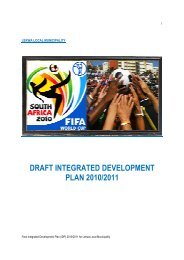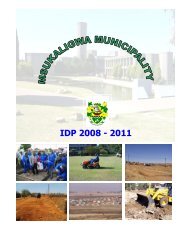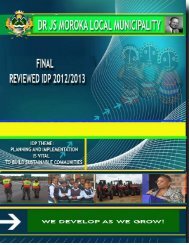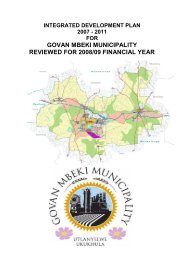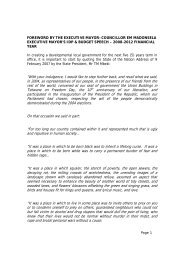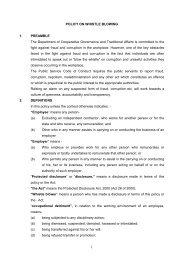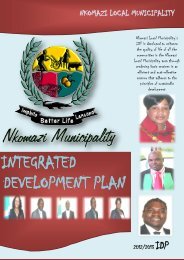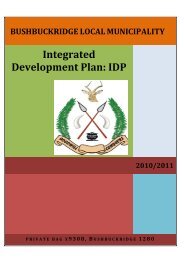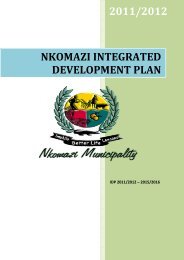Lekwa Local Municipality 2013/14 - Co-operative Governance and ...
Lekwa Local Municipality 2013/14 - Co-operative Governance and ...
Lekwa Local Municipality 2013/14 - Co-operative Governance and ...
You also want an ePaper? Increase the reach of your titles
YUMPU automatically turns print PDFs into web optimized ePapers that Google loves.
“To be the leading, people centered municipality excelling in economic growth, development <strong>and</strong> governance”South Africa will become a nation in which investment in infrastructure <strong>and</strong> development programmes supportgovernment’s growth <strong>and</strong> development objectives: By focusing economic growth <strong>and</strong> employment creation in areas where this is most effective <strong>and</strong>sustainable; Supporting restructuring where feasible to ensure greater competitiveness; Fostering development on the basis of local potential; <strong>and</strong> Ensuring that development institutions are able to provide basic needs throughout the countryThe basic principles of the NSDP underpinning this vision are:Economic growth is a prerequisite for the achievement of other policy objectives, key among whichwould be poverty alleviation.Government spending on fixed investment, beyond the constitutional obligation to provide basicservices to all citizens (such as water, electricity as well as health <strong>and</strong> educational facilities), shouldtherefore be focused on localities of economic growth <strong>and</strong>/or economic potential in order to attractPrivate-sector investment, stimulate sustainable economic activities <strong>and</strong>/or create long-termemployment opportunities.Efforts to address past <strong>and</strong> current social inequalities should focus on people not places. In localitieswhere there are both high levels of poverty <strong>and</strong> development potential, this could include fixedcapital investment beyond basic services to exploit the potential of those localities. In localities withlow development potential, government spending, beyond basic services, should focus on providingsocial transfers, human resource development <strong>and</strong> labor market intelligence. This will enable peopleto become more mobile <strong>and</strong> migrate, if they choose to, to localities that are more likely to providesustainable employment or other economic opportunities.In order to overcome the spatial distortions of apartheid, future settlement <strong>and</strong> economicdevelopment opportunities should be channeled into activity corridors <strong>and</strong> nodes that are adjacentto or link the main growth centers.The NSDP therefore uses the two crucial notions of need <strong>and</strong> potential to describe the space economy <strong>and</strong>thereby frame the parameters within which infrastructure investment <strong>and</strong> development spending are to beplanned. In this sense the NSDP provides a concrete mechanism in terms of which integrated developmentplanning in the local sphere, provincial planning <strong>and</strong> national spatial guidance can be formally linked insupport of national priorities <strong>and</strong> objectives. The coordinated achievement of national objectives guided bythe vision <strong>and</strong> principles of the NSDP as set out above, however is dependent on:Awareness of <strong>and</strong> buy-in to the NSDP vision <strong>and</strong> its principles by all organs of government;The linkage <strong>and</strong> alignment of the PGDS, IDPs, as well as sectoral, departmental <strong>and</strong> financialplanning in all spheres of government;The extent to which the NSDP <strong>and</strong> its principles find practical manifestation in the PGDS, IDPs<strong>and</strong> sector department plans;Dialogue between spheres <strong>and</strong> between departments <strong>and</strong> institutions within spheres ondevelopment potential <strong>and</strong> poverty/need within particular localities;Annual comments <strong>and</strong> reports by organs of government on how their strategies are informedby the NSDP principles <strong>and</strong> their comments on the spatial narrative <strong>and</strong> maps in the NSDP.The NSDP is not a plan but a perspective that acts as a policy co-ordination <strong>and</strong> indicative planning tool for allspheres of government. It is therefore characterized by an ongoing process of elaboration, refinement <strong>and</strong>revision that requires input from all three spheres of government. In this regard project teams are currentlyreviewing <strong>and</strong> updating the NSDP in three parallel projects:Key interventions for the harmonization <strong>and</strong> alignment of IDPs, PGDSs <strong>and</strong> the NSDP23 | P a g e - D r a f t i n t e g r a t e d D e v e l o p m e n t P l a n 2 0 1 3 / 2 0 1 4



